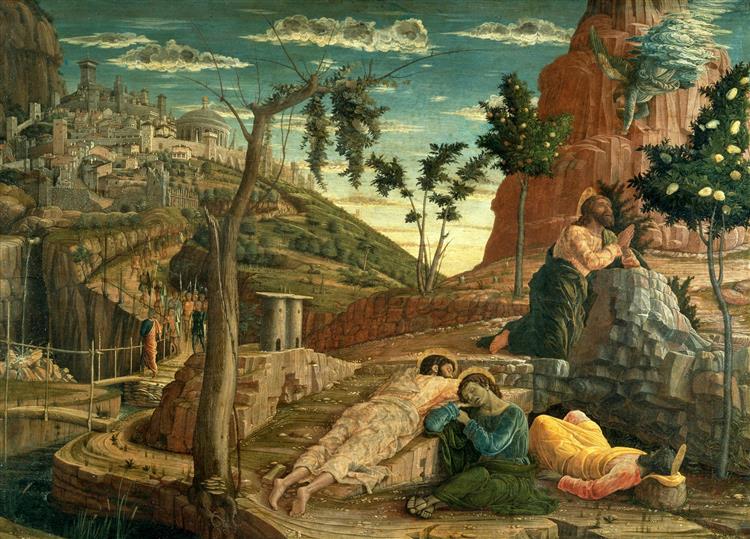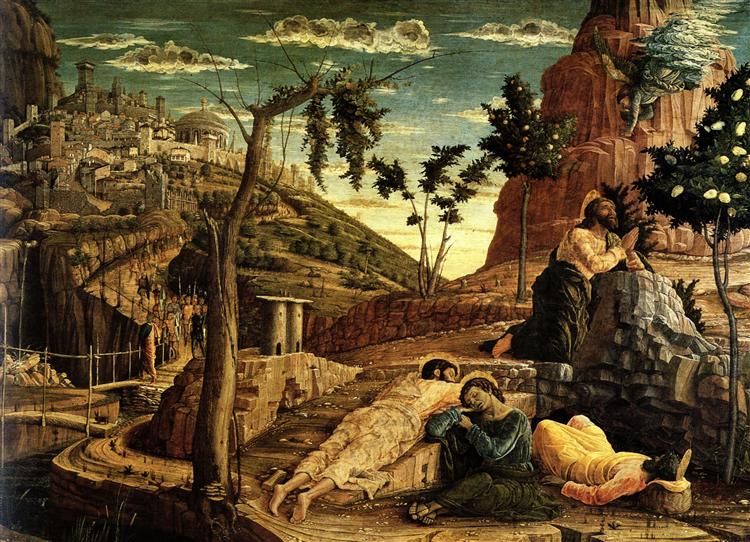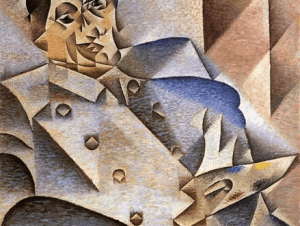Andrea Mantegna was a master of the Early Renaissance whose work is immediately recognizable for its sharp, sculptural quality and intense emotional depth. His painting, Agony in the Garden (c. 1457-1459), is a prime example of his revolutionary style. It transforms a familiar biblical narrative into a stark, unforgettable vision of psychological turmoil and divine destiny.
Housed in the Musée des Beaux-Arts de Tours in France, this masterpiece invites viewers into a world that feels both ancient and shockingly immediate, carved into existence by Mantegna’s precise and powerful brush.

Prayer in the Garden by Andrea Mantegna
The Scene: A Moment of Divine and Human Struggle 
The painting depicts the poignant moment in the Garden of Gethsemane on the night before the Crucifixion. Jesus, knowing his fate, has gone to pray. The key elements of the narrative are laid out with crystalline clarity:
Jesus in Prayer: In the upper right, Christ kneels on a rocky outcrop, his gaze directed toward an angel who appears bearing the instruments of the Passion—the cross and the column of flagellation.
The Sleeping Apostles: In the foreground, his closest disciples—Peter, James, and John—are fast asleep, oblivious to their master’s anguish and the impending danger. Their slumber highlights Christ’s isolation in his moment of trial.
The Betrayal: In the middle distance, Judas Iscariot leads a procession of Roman soldiers across a bridge, coming to arrest Jesus.
Mantegna’s Sculptural Vision 
What makes this painting so powerful is Mantegna’s unique artistic approach. He was deeply influenced by classical sculpture and archaeology, and he treated painting as a form of relief carving.
The Human Figures
Every figure in the composition, from the sleeping apostles to the praying Christ, has a tangible, statuesque quality. The drapery folds are not soft but sharp and defined, as if chiselled from marble. Mantegna uses skillful foreshortening on the figures in the foreground, giving them a realistic weight and presence while also reinforcing their stony stillness.
The Rocky Setting
The landscape is not a welcoming garden but a harsh, barren, and almost metallic world. The rocks are fractured and sharp-edged, creating a sense of unease and severity. This unforgiving environment is a hallmark of Mantegna’s style, and it serves as a powerful metaphor for the harshness of the events about to unfold. The very earth seems to reflect Christ’s inner torment.
A Landscape of Symbolism
Mantegna packs his composition with rich symbolic detail that adds layers of meaning to the scene.
The Barren Tree: A dead tree with a single living shoot often symbolizes the coming death of Christ (the Crucifixion) and the promise of his future Resurrection.
The Cityscape: The meticulously detailed city in the background is a fantastical version of Jerusalem, blending recognizable Roman landmarks like an amphitheatre and an equestrian statue with contemporary architecture. This was Mantegna’s way of connecting the sacred history of the Bible with the classical world revered by Renaissance humanists.
The Approaching Soldiers: Judas leads the soldiers out of the city and across a bridge, symbolizing the final, fateful step toward betrayal and death.
Key Facts at a Glance
Artist: Andrea Mantegna (c. 1431-1506)
Title: Agony in the Garden (also Prayer in the Garden)
Date: circa 1457–1459
Style: Early Renaissance
Medium: Tempera and oil on panel
Dimensions: 71.1 x 93.7 cm (28 x 36.9 in)
Location: Musée des Beaux-Arts de Tours, Tours, France
Viewing the Masterpiece in Tours
To fully appreciate the incredible detail and emotional force of this painting, it is best seen in person. As a key work of the Italian Renaissance, it is a highlight of the collection at the Musée des Beaux-Arts in Tours. Before visiting, be sure to check the museum’s official website for opening hours and any specific viewing information.
Recommend0 recommendationsPublished in Art History, Artworks








Responses